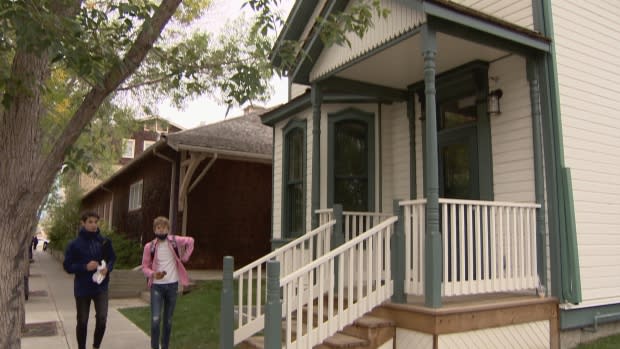Calgary's Francophone roots represented in new heritage designations, experts say
Two buildings in Mission that historians say represent important facets of Calgary's Francophone roots have received heritage designations that will protect them from demolishment or alterations to historic elements.
City council approved the designation of St. Mary's Parish Hall/CNR Station and the Rouleau residence as municipal historic resources on Monday.
"Heritage buildings and historic neighbourhoods enhance our perspective," Mayor Naheed Nenshi said at city council.
"They enhance our understanding and our awareness of the past that helped build a sense of identity."
For historian and writer Ken LaPointe, who has dedicated much of his work to sharing and safeguarding Calgary's Francophone legacy, the preservation of the two sites is integral to understanding the city's history.
"It's about recognition for people who have been largely overlooked, and that's the Francophone history of Calgary and Alberta in general," LaPointe said.
Rouleauville's history
The neighbourhood of Mission used to be a French village called Rouleauville, and was named after the Rouleau family, who helped found the town.
And according to LaPointe, this often-overlooked history was nearly erased when the city annexed the town in 1907 and changed its name.
"Most people don't realize that Rouleauville was secured in 1883 … a full year before Calgary was incorporated as a town," LaPointe said.
"By changing the name of the area, a lot of the Francophone history has been somewhat lost or intentionally obliterated.… So our work has been to, first of all, educate and do what we can to at least see a balance and the recognition for that Francophone history."

Suzanne de Courville Nicol, who shares Calgary's diverse history through her role as president of Bureau de Visibilité de Calgary, told CBC News that the community had a tremendous impact on the city.
"All the social fabric of Calgary as it is today began here, in Rouleauville, with the French priests and nuns who were sent here to Christianize the people who were here — but who came from everywhere," Nicol said.
"Some from Ireland, some from Scotland, but they all spoke French."
The residence and the train station
The now-protected Rouleau residence was home to Dr. Édouard-Hector Rouleau, who lived with his family in this home from 1887 to about 1902, according to the city.
The residence faced demolition in 2003 but was saved by the city and a coalition of community organizations. In 2005, it was moved to its present site, which is next to the St. Mary's Parish Hall/CNR Station.
De Courville Nicol says its designation is cause for celebration, and if she had a hope for the space, it would be to see it as a museum that recognizes significant figures in Rouleauville's history.
"[It is] wonderful that finally this … house will be protected now," said de Courville Nicol. "And it has been recognized officially as a historic site by the City of Calgary."

The CNR Station was built in 1905 as a parish hall for French settlers in Rouleauville, and became a train station in 1911.
Today, the hall that served as a railway station is used by Alberta Ballet. Its designation makes it Calgary's 100th municipal historic resource.
"Designating the St. Mary's Parish Hall/CNR Station as a municipal historic resource enables us to protect a unique building that showcases different elements of Calgary's past," said Josh Traptow, executive director of Heritage Calgary, in a news release.
According to LaPointe, the designations represent wins in a larger battle to preserve the richness of Calgary's history.
"[It's] tremendous, but it's ongoing. We cannot stop," LaPointe said.


